Drawdown tactics
When lake managers draw down reservoirs, fish behavior changes, and savvy anglers alter their strategies accordingly
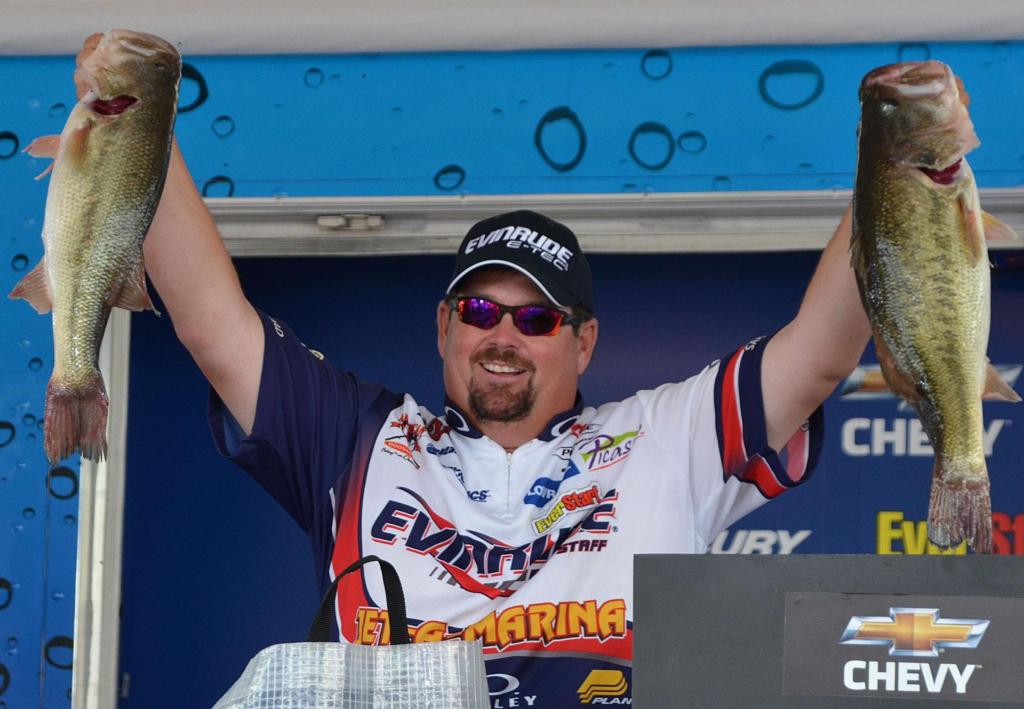
(Editor’s note: This article originally appeared in the 2013 August/September issue of Bass Fishing magazine. To read more compelling articles from Bass Fishing magazine each month, become an FLW subscriber member. If you’d like to sign up for a digital subscription to access articles online, click here).
The bass were gone. That was all Dan Morehead knew, and all that mattered. Prior to the start of that first practice morning of the 2011 EverStart Series Championship, the Kentucky Lake expert had been as excited as he’d ever been about a tournament. After all, only a couple of weeks earlier, he’d enjoyed some of his best days ever on the big lake, and he figured the stretch of good fishing would continue.
“I could have weighed 28 or 29 pounds on a couple of days,” he recalls about the period leading up to practice. Largemouths and smallmouths were stacked on main-lake bars, and Morehead had their number.
As summer winds down, however, things can change quickly on a drawdown lake – a reservoir where lake managers reduce the water level in late summer and early fall. Come practice for the EverStart showdown, Morehead’s fish were nowhere to be found. In fact, despite the amazing pre-practice, Morehead didn’t catch a fish during the first day and a half of practice. The dropping lake and progressing season had caused everything to change.
What Morehead figured out was that his main-lake fish had abandoned ship once the water level began to show a significant drop, and several groups of fish had moved into bays. They were holding on bars made shallow by the drawdown and suspending over slopes into deep water along the bars’ edges.
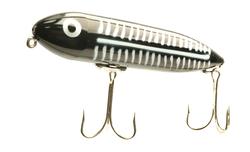 Morehead recognized their move, and saw the need to change his game. And with a Heddon Zara Spook and Mann’s Slick Lures Alabama Rig in hand, he followed the fish to a drawdown season victory in the EverStart Series Championship. His strategy can help you too, when the annual drawdown runs bass out of your honeyholes.
Morehead recognized their move, and saw the need to change his game. And with a Heddon Zara Spook and Mann’s Slick Lures Alabama Rig in hand, he followed the fish to a drawdown season victory in the EverStart Series Championship. His strategy can help you too, when the annual drawdown runs bass out of your honeyholes.
What happens?
Reservoirs get drawn down for a variety of reasons, mostly related to seasonal rains, power production and flood control. On big river systems such as the Tennessee River, where multiple dams impound the main river and various tributaries, it gets complex. The steepness of the terrain and land-use patterns around individual reservoirs also factor into the plan of when the drawdown begins, how quickly the water falls and at what level it ultimately settles.
Understandably, power companies prefer to run water when it can go through generators and produce power. Pouring water over spill gates is like washing money over the dam. Dropping reservoir levels in the fall helps avert flooding from winter storms and heavy spring rains while allowing the companies to run water at beneficial times.
On some impoundments, including Kentucky Lake, the drawdown begins late in the summer and lasts a few months. It’s gradual, therefore, and while water levels continually fluctuate, the general trend is downward from about July to October.
Fish move
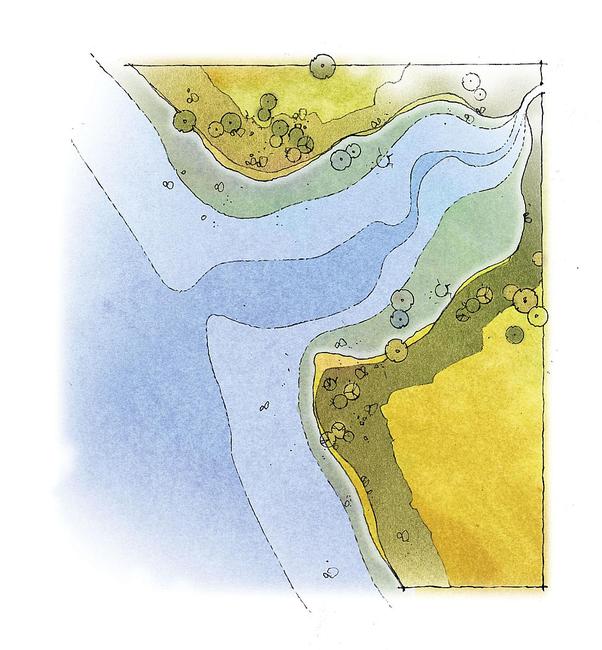 Because the change is gradual, anglers don’t always expect it to have much impact on the fish’s behavior. But the changing water level definitely does impact the fish’s positioning, just not necessarily in the ways that would be expected.
Because the change is gradual, anglers don’t always expect it to have much impact on the fish’s behavior. But the changing water level definitely does impact the fish’s positioning, just not necessarily in the ways that would be expected.
“Everyone always assumes that when the water goes down, the fish pull back, moving down the same structures into deeper water or moving to deeper structure, but that really doesn’t happen much,” Morehead says. “In fact, as the water is going down in the fall, I’m usually moving farther up into the bays and fishing shallower, instead of the other way around.”
It’s worth noting that the total cause-and-effect of the bass’ fall movements is somewhat hard to pin strictly to the drawdown or any other isolated factor because multiple changes occur at once.
“The water level drops from late summer through fall, but at the same time the shad are moving back in the creeks, and there is usually less current in the river,” Morehead says. “Oxygen levels also play a part. And all the fish in the lake don’t do the same things. While some move into bays, others don’t leave the main river.”
It is also worth noting that impoundments of major rivers like the Tennessee and the Arkansas, where significant current commonly comes into play and where drawdowns are modest, are somewhat distinctive in terms of fish behavior during the fall. In deep tributary reservoirs, which may get drawn down 30 or more feet and where minimal current impacts fish, the bass react differently when water levels go down. They are forced to move to down points or to use deeper humps because flats inside bays get left high and dry from the hard draws.
Disclaimers made, you can often track bass as they react to autumn drawdowns through a series of three temporary pit stops.
1. Bass movement begins within the main river channel late in the summer. As water temperatures peak and levels begin to creep down, the fish move up onto structure adjacent to ledges and often will be a couple of cast’s distance from a break.
“A lot of people think that’s when they go the deepest, but it’s not,” Morehead says. “They actually move shallower, maybe because of cooler water from the current.”
2. As summer gives way to fall, the same fish move into bays, initially positioning themselves along the last breaks in deeper water at the edges of the bays – often suspending, especially if there’s little current. That was where a lot of fish were during Morehead’s EverStart Series Championship win. Others were farther back, but still over shallow bars and their adjacent drops into deeper water.
3. As fall progresses, the shad and the bass tend to work their way farther back to the pockets, first hitting secondary points and bay flats and eventually moving as far back as water levels allow in any bay that’s not overly silted. It’s not a singular migration, though. Some move farther than others, and they also become increasingly scattered as the season progresses.
Tactics
When bass key on schooling shad and suspend in the water column as they often do during the fall, Morehead hasn’t found anything that does the job better than an Alabama Rig. His EverStart Series Championship win was one of the events that helped introduce this style of rig to the nation’s bass fishermen, but he actually had been experimenting with it for a few months prior to the tournament and already had gained great confidence and competence fishing the then-new rig.
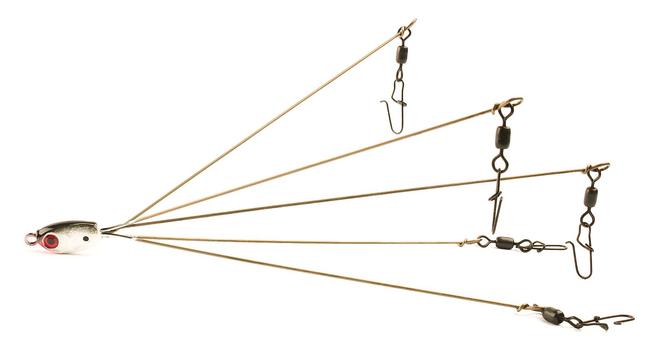 Umbrella rigs mostly get associated with deep fish, but Morehead actually was casting far up into shallow water and swimming a rig quickly with the rod tip high – enough so, even, that one bait would be skipping on top – and a few fish hit the rig as it moved like a buzzbait. He would then slow down the retrieve to work the rig down the slope or swim it over the slope for suspended fish. To find the fish that are most willing to bite, it’s important to swim an umbrella rig through different levels of the water column.
Umbrella rigs mostly get associated with deep fish, but Morehead actually was casting far up into shallow water and swimming a rig quickly with the rod tip high – enough so, even, that one bait would be skipping on top – and a few fish hit the rig as it moved like a buzzbait. He would then slow down the retrieve to work the rig down the slope or swim it over the slope for suspended fish. To find the fish that are most willing to bite, it’s important to swim an umbrella rig through different levels of the water column.
Beyond an umbrella rig, other important lures for Morehead during the fall drawdown include walking-style topwater lures, lipless crankbaits and spinnerbaits. A Spook, which has long been one of Morehead’s go-to lures for this situation, accounted for a couple of important fish on the first day of the EverStart Series Championship.
Major common denominators are that these lures imitate shad effectively, and you can cover water with them. Fish quickly, but pay careful attention to details when you do catch fish. Also watch for the shad at all times, because the fall feed is on during this time.
More strategy
Like almost any time of year on reservoirs that experience substantial current, moving water is important during the fall drawdown period.
“If you’re going to fish on a lake like this, you had better know that generation schedule by heart,” Morehead says. “The current dictates everything.”
Fall commonly brings steady generation during the week followed by far less flow on Saturday and Sunday, although at times once the lake is low and when rain is slow, extended periods with little current might take hold. Main-lake fish – especially deep main-lake fish – don’t bite nearly as well when the water stops running, which is why anglers focusing exclusively on main-lake ledges commonly bring in massive bags for a day and then disappear from the top of the standings during fall tournaments. It’s also why practice fish often don’t materialize on tournament day.
“If you do see that the water will be running for a few hours in the morning, you might want to start on the main river while there is current, then move in the bays when the water stops.” Morehead adds.
Another important consideration back in the bays is that after generation through the dam at the lower end of a pool ceases, the water level sometimes rises a few inches. It doesn’t look much different on the bank, so conditions seem the same, but the usual result is that bass that have been on the bottom will suspend.
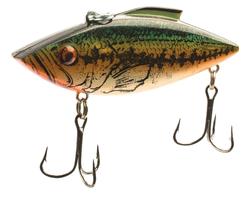 Most importantly this time of year, be ready to cover a lot of water for drawdown fishing. Because the fish scatter, it’s critical to use moving lures, to hit a lot of bays and to pay careful attention to where the most fish are positioned within each bay. Monitor the baitfish, because they too respond to falling water levels, and where the bait goes, the bass go. Most importantly, recognize that when the ceiling starts to lower, the bass respond to the ensuing fall season. The angler who responds in like fashion stays on the bite.
Most importantly this time of year, be ready to cover a lot of water for drawdown fishing. Because the fish scatter, it’s critical to use moving lures, to hit a lot of bays and to pay careful attention to where the most fish are positioned within each bay. Monitor the baitfish, because they too respond to falling water levels, and where the bait goes, the bass go. Most importantly, recognize that when the ceiling starts to lower, the bass respond to the ensuing fall season. The angler who responds in like fashion stays on the bite.
Jig stroking
Tennessee River veterans sometimes talk about “stroking” a jig, which refers to working a jig off the bottom with big vertical jumps through sharp lifts of the rod. Suspended fish usually hit the lure at its apex or on the fall.
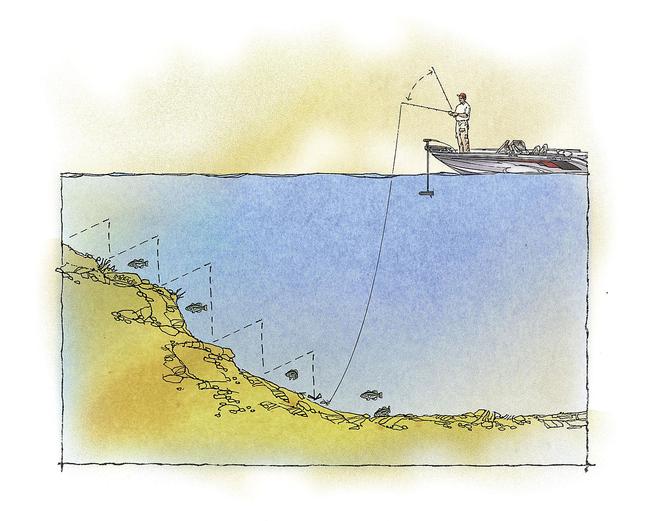 Stroking commonly comes into play during the drawdown because when fish suspend, each stroke puts the jig at the level of the bass just long enough to prompt a reaction strike. It’s especially effective when the dam keepers shut off the water, creating a slight rise in the lake level and causing fish that have been holding atop slopes within the bays to suspend just over the structure. Those fish can become tough to catch with traditional bottom presentations.
Stroking commonly comes into play during the drawdown because when fish suspend, each stroke puts the jig at the level of the bass just long enough to prompt a reaction strike. It’s especially effective when the dam keepers shut off the water, creating a slight rise in the lake level and causing fish that have been holding atop slopes within the bays to suspend just over the structure. Those fish can become tough to catch with traditional bottom presentations.